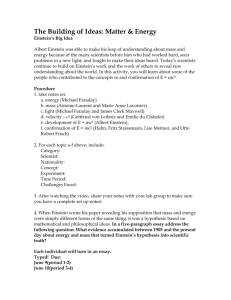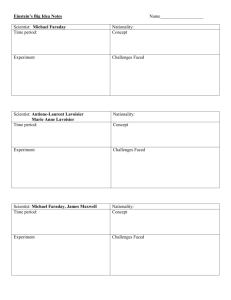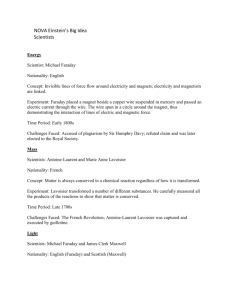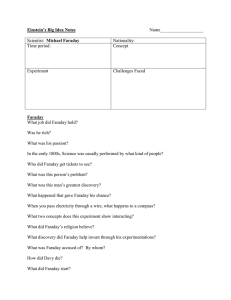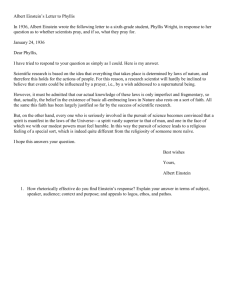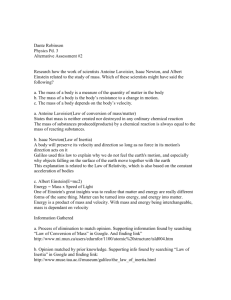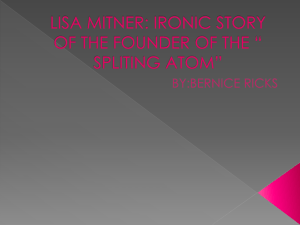Einstein's Big Idea Questions
advertisement
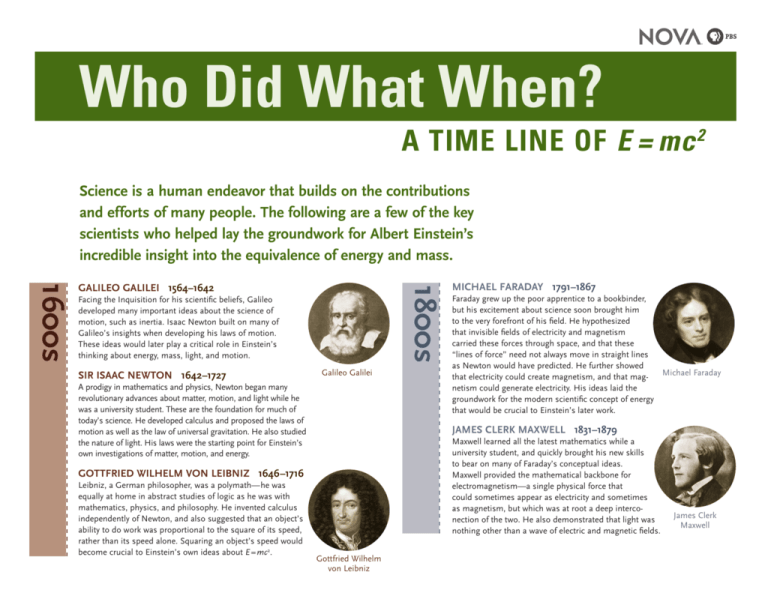
Who Did What When? A TIME LINE OF E = mc 2 Science is a human endeavor that builds on the contributions and efforts of many people. The following are a few of the key scientists who helped lay the groundwork for Albert Einstein’s incredible insight into the equivalence of energy and mass. 1800s 1600s GALILEO GALILEI 1564–1642 Facing the Inquisition for his scientific beliefs, Galileo developed many important ideas about the science of motion, such as inertia. Isaac Newton built on many of Galileo’s insights when developing his laws of motion. These ideas would later play a critical role in Einstein’s thinking about energy, mass, light, and motion. SIR ISAAC NEWTON 1642–1727 Galileo Galilei A prodigy in mathematics and physics, Newton began many revolutionary advances about matter, motion, and light while he was a university student. These are the foundation for much of today’s science. He developed calculus and proposed the laws of motion as well as the law of universal gravitation. He also studied the nature of light. His laws were the starting point for Einstein’s own investigations of matter, motion, and energy. Faraday grew up the poor apprentice to a bookbinder, but his excitement about science soon brought him to the very forefront of his field. He hypothesized that invisible fields of electricity and magnetism carried these forces through space, and that these “lines of force” need not always move in straight lines as Newton would have predicted. He further showed Michael Faraday that electricity could create magnetism, and that magnetism could generate electricity. His ideas laid the groundwork for the modern scientific concept of energy that would be crucial to Einstein’s later work. JAMES CLERK MAXWELL 1831–1879 Maxwell learned all the latest mathematics while a university student, and quickly brought his new skills to bear on many of Faraday’s conceptual ideas. Maxwell provided the mathematical backbone for electromagnetism—a single physical force that could sometimes appear as electricity and sometimes as magnetism, but which was at root a deep interconection of the two. He also demonstrated that light was nothing other than a wave of electric and magnetic fields. GOTTFRIED WILHELM VON LEIBNIZ 1646–1716 Leibniz, a German philosopher, was a polymath—he was equally at home in abstract studies of logic as he was with mathematics, physics, and philosophy. He invented calculus independently of Newton, and also suggested that an object’s ability to do work was proportional to the square of its speed, rather than its speed alone. Squaring an object’s speed would become crucial to Einstein’s own ideas about E = mc2. MICHAEL FARADAY 1791–1867 Gottfried Wilhelm von Leibniz James Clerk Maxwell This talented woman mastered the mathematics and physics of her day. She was the first person to translate Newton’s great works into French. She also clarified Leibniz’s ideas about objects in motion. In particular, by analyzing Dutch researcher Willem ’sGravesande’s experiment of dropping balls into soft clay, du Châtelet helped champion the idea that squaring an object’s speed determined how much work it could do. She thus helped put in place a crucial piece of Einstein’s E = mc2. 1900s 1700s EMILIE DU CHÂTELET 1706–1749 Emilie du Châtelet This husband-and-wife team helped to reinvent modern physics, much as the Lavoisiers had done for chemistry many years earlier. Pierre and Marie Curie studied radioactivity and discovered new radioactive elements, such as radium and polonium. Their work led to a new understanding of radioactivity—a process in which matter decays and releases energy—made possible by E = mc2. ALBERT EINSTEIN 1879–1955 ANTOINE-LAURENT LAVOISIER 1743–1794 MARIE ANNE PAULZE LAVOISIER 1758–1836 This husband-and-wife team helped usher in a new era for the science of chemistry. Antoine-Laurent demonstrated that the total amount of matter is conserved in any chemical reaction—some of it might change form from solid, liquid, or gas, but the total amount remains the same before and after the reaction takes place. Working at her husband’s side, Marie Anne made detailed drawings and engravings of laboratory apparatus and experiments, and translated the works of other scientists. PIERRE CURIE 1859–1906 MARIE SKLODOWSKA CURIE 1867–1934 Antoine-Laurent Lavoisier A stubborn visionary, Einstein developed some of the most revolutionary ideas in the history of science. While working as a patent clerk, he introduced a fundamentally new basis for understanding the most basic ideas of physics—space, time, matter, and energy. Among his major insights: energy and mass are two forms of the same thing. Each can be transformed into the other, with Albert Einstein c2 as the conversion factor—a number so huge that a tiny amount of mass is equal to an enormous amount of energy. OTTO HAHN 1879–1968 FRITZ STRASSMANN 1902–1980 These two chemists had worked closely with physicist Lise Meitner in Berlin, until Meitner was forced to flee Nazi Germany. They experimented by bombarding uranium’s heavy nuclei with neutrons. Expecting the nuclei to simply absorb the incoming neutrons, they could not explain their subsequent results—lighter elements, such as barium, were produced. Hahn wrote to Meitner for help explaining the puzzling results; she realized that Hahn and Strassmann had generated nuclear fission, early evidence that confirmed Einstein’s E = mc2. Otto Hahn LISE MEITNER 1878–1968 OTTO ROBERT FRISCH 1904–1979 TUNE IN Time Line Author Written by David Kaiser, an associate professor in the MIT Program in Science, Technology, and Society, and a lecturer in the MIT physics department. “Einstein’s Big Idea” airs on PBS October 11, 2005 www.pbs.org/nova/einstein Meitner, a physicist, worked for years with chemists Otto Hahn and Fritz Strassmann to study the behavior of nuclei. She was forced to flee Nazi Germany because of her Jewish ancestry. Soon after leaving Berlin, she received some reports from Hahn about the latest experimental data. With her nephew, physicist Otto Robert Lise Meitner Frisch, Meitner was the first to understand that uranium nuclei could be split when bombarded by neutrons. Meitner and Frisch calculated how much energy would be released each time a uranium nucleus underwent fission, a dramatic example of E = mc2 at work. Questions for Einstein’s Big Idea 1. What did Michael Faraday discover that affects our every day lives 2. How did the Lavoisier’s demonstrate conservation of mass? 3. How did Madame de Chatelet show that Energy is proportional to v2 4. What does E = mc2 mean? How would you explain it to your friends? 5. How did Lise Meiner and associates validate E = mc2 6. What are some applications of E=mc2 Questions for Einstein’s Big Idea 7. What was the most interesting thing you learned about from watching the DVD? 8. What do thing was the most important thing you learned from the DVD? 9. Should I show this DVD to my next Physics 102 class? Why or why not?
